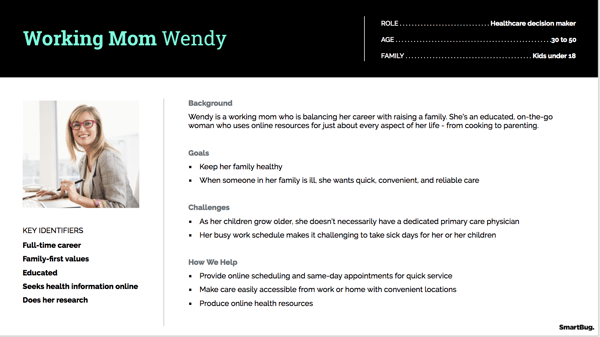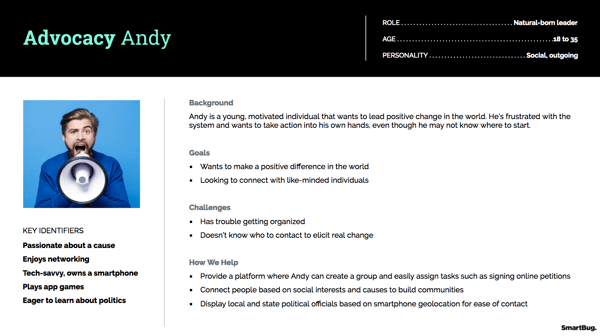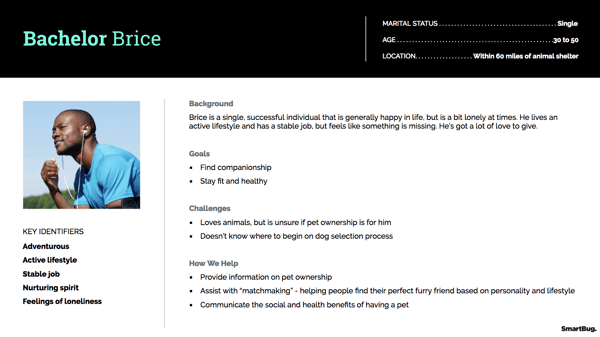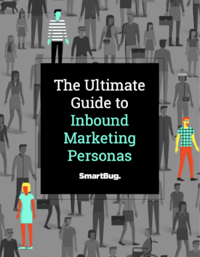
3 Examples of Buyer Personas to Help You Create Your Own
December 30, 2019
By Alex Cusick
Buyer personas. You’ve heard about them over and over again. You know you need personas in order for your marketing to be successful, but you still haven’t created them. What’s holding you up? Do you not know where to start? Or are you not quite sure what a finished persona should look like?
Well, it’s time to take off your procrastination pants and put on your persona pants, because I’ve put together three examples of buyer personas that you can use as a guide to build your own:
- Healthcare Network Persona: Working Mom Wendy
- Mobile App Persona: Advocacy Andy
- Animal Shelter Persona: Bachelor Brice
For each example, I recreated a persona from three different industries I’ve worked in: healthcare, technology (specifically, mobile apps), and animal rescue (a.k.a. animal shelters). Now remember, if you work in one of these industries, it’s important to create your own, unique buyer personas based on interviews and research specific to your organization. To learn more about buyer persona research, check out our Ultimate Guide to Inbound Marketing Personas.
Once you have your persona data, the real fun begins. Now we can take all of those insights and create a fictional but accurate representation of a specific person in our target audience whom we’ve identified as an ideal prospect. We’ll give that persona a name and a face, and we’ll start to build their story. That story, in turn, will give us direction on how to best reach these people with marketing efforts.
Let’s dive in!
1. Healthcare Network Persona Example: Working Mom Wendy
When I worked in healthcare, we had a number of people to market to, but again, personas are about dialing into each unique group on an individual level. In this case, one primary target group included working mothers. Thus, one of our personas was “Working Mom Wendy.” As always, we started with persona interviews, took key insights from those interviews, compiled the data, and created her persona card (which you can download a template of). The persona card looked like this:

How to Use This Information for Marketing
The “How We Help” section of the buyer persona is designed to address your persona’s goals and challenges. This gives you a good idea of what should be included in the messaging of your ads. In this example, we know that Wendy is a busy woman, so we’ll use targeted ads featuring our same-day appointments and convenient locations.
We also know that Wendy uses the internet as a resource for information. This gives us a few clues of how we can best market to Wendy. First, because we know Wendy is often surfing the web, online marketing efforts such as inbound marketing or paid digital media should be used. Second, creating a blog with health and wellness information, such as at-home remedies for common ailments or healthy family recipes, could be a great way to build a relationship with Wendy. We could even encourage her to subscribe for email updates on top stories.
Finally, Wendy may not have a dedicated primary care physician and she may want to find a provider she can trust. Posting easy-to-find online reviews of our physicians, along with their locations, will make Wendy’s selection process much easier, improving her overall satisfaction and increasing the chances she’ll select one of our providers.
2. Mobile App Persona Example: Advocacy Andy
At this particular tech organization, we created a free mobile app that was built for social action. One of our primary buyer personas was Advocacy Andy, someone who was looking for a tool to assist his mission for change.

How to Use This Information in Marketing
Here again, we can use the “How We Help” section to guide our marketing messages to Andy. We can also use some key identifiers to determine the best marketing channels to reach Andy. For example, we know that Andy is eager to learn about politics so he can advance his efforts. Creating relevant downloadable e-books and guides is a great way to provide Andy with something valuable while capturing his information for lead nurturing.
Additionally, Andy is a smartphone user and enjoys app games. Mobile advertising or SMS alerts could prove successful. Gamification of the app with task completion rewards could also appeal to his gamer side, enticing him to download the app and even become a promoter of the app through social sharing of his earned rewards.
3. Animal Shelter Persona Example: Bachelor Brice
Who doesn’t love animals? OK, maybe there are a few people out there, but when I worked at an animal shelter, our adopters came from all walks of life, so we had a lot of personas. You know who’s a great candidate for dog adoption? Bachelor Brice.

How to Use This Information in Marketing
From Brice’s persona, we can see that one of his biggest reservations is that he’s unsure if pet ownership is right for him. We can guide him through the journey of this decision with blog posts or downloadable guides related to frequently asked questions, training tips, general pet care, and more. Because Brice is also a health nut, creating a blog series dedicated to the health benefits of pet ownership would be appealing.
Matchmaking could be effective on a couple of different levels. First, it will help Brice decide what type of dog to adopt. Next, it will also speak to his need for companionship. This matchmaking tactic can be executed via a blog series, an online quiz, or a networking event, where Brice could even meet other singles.
Originally written on March 6, 2018. Content was updated December 2019.
About the author
Alex Cusick was formerly a Marketing Specialist at SmartBug who abhors talking about himself in the third person. He is passionate about using marketing to help clients foster relationships and tell compelling stories. Read more articles by Alex Cusick.










